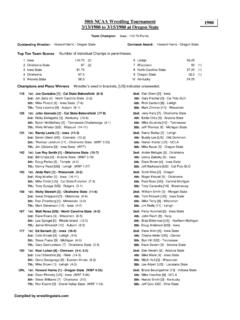Transcription of A NEW GUIDE TO FISH FARMING IN KENYA - Oregon State …
1 IN KENYAFISH FARMING A NEW GUIDE TOAquaculture Collaborative Research Support ProgramCharles C. Ngugi | James R. Bowman | Bethuel O. OmoloA N e w G u i d e t o F i s h F a r m i n g i n K e n y a C h a r l e s C . N g u g i | J a m e s R . B o w m a n | B e t h u e l O . O m o l oISBN 978-0-9798658-0-0A New GUIDE to fish FARMING in KenyaCharles C. NgugiDepartment of Fisheries and Aquatic Sciences, Moi university James R. BowmanDepartment of Fisheries and Wildlife, Oregon State UniversityBethuel O.
2 Omolo Fisheries Department, Ministry of Livestock and Fisheries Development, Government of KENYA Design by Beth Kerrigan and Aaron ZurcherCover photo by Charles C. NgugiAquaculture CRSP Management Office College of Agricultural Science Oregon State university 418 Snell Hall Corvallis, Oregon 97331 1643 USAA quacul t ure CRSPUS Institutions: Oregon State UniversityKenyan Institutions: Department of Fisheries and Aquatic Sciences, Moi UniversityFisheries Department, Ministry of Livestock and Fisheries Development, Government of KenyaThis publication is made possible under the sponsorship of USAID under Grant No.
3 LAG-G 00 96 90015 00 and the collaborating US and international institutions. In the spirit of science, the Program Management Office of the Aquaculture Collaborative Research Support Program (ACRSP) realizes the importance of providing a forum for all research results and thought and does not endorse any one particular view. The opinions expressed herein are those of the authors and do not necessarily represent an official position or policy of the United states Agency for International Development (USAID) or the Aquaculture CRSP. Mention of trade names or commercial products does not constitute endorsement or recommendation for use on the part of USAID or the Aquaculture CRSP.
4 The authors are solely responsible for the accuracy, reliability, and originality of work presented here, and neither USAID nor the Aquaculture CRSP can assume responsibility for the consequences of its use. All rights reserved. 2007 Aquaculture CRSPISBN 978-0-9798658-0-0Co n t e n t sChapter 1: Aquaculture Planning .. : Selecting a good pond site .. : Integrating fish culture into your farm .. : Marketing your fish ..10 Chapter 2: Pond Design and Construction .. : Pond design and layout .. : Pond construction ..22 Chapter 3: Species Suitable for Culture in KENYA .
5 : Nile tilapia, Oreochromis niloticus .. : African catfish. Clarias gariepinus ..34 Chapter 4: Fishpond Management .. : Preparing your fishpond for stocking .. : Stocking your fishpond .. : Feeding your fish .. : Managing water and soil quality in your pond .. : Preventing fish diseases and controlling predators .. : Harvesting your fish .. : Intensifying production in your fishponds .. : Keeping fish farm records ..65 Chapter 5: Hatchery Management .. : General hatchery considerations .. : Tilapia seed production .. : Catfish seed production.
6 81 Chapter 6: fish FARMING : Enterprise budgets .. : Cash flow analysis ..93In t r o d uC t I o nKenya is endowed with numerous aquatic resources with aquacultural potential. It has highly varied climatic and geographic regions, covering a part of the Indian Ocean coastline, a portion of the largest freshwater lake in Africa (Lake Victoria), and several large rivers, swamps, and other wetlands, all of which support an abundance of native aquatic species. These aquatic environments range from marine and brackish waters to cold and warm fresh waters, and many can sustainably contribute to the operation of ponds for fish fish FARMING in ponds began in KENYA in the 1920s, initially using tilapia species and later including the common carp and the African catfish.
7 In the 1960s rural fish FARMING was popularized by the KENYA Government through the Eat More fish campaign; as a result of this effort, tilapia FARMING expanded rapidly, with the construction of many small ponds, especially in KENYA s Central and Western Provinces. However, the number of productive ponds declined in the 1970s, mainly because of inadequate extension services, a lack of quality fingerlings, and insufficient training for extension workers. Until the mid 1990s, fish FARMING in KENYA followed a pattern similar to that observed in many African countries, characterized by small ponds, subsistence-level management, and very low levels of , following the renovation of several government fish rearing facilities, the establishment of research programs to determine best practices for pond culture, and an intensive training program for fisheries extension workers, there is renewed interest in fish FARMING in KENYA .
8 Farmers in suitable areas across the country are again turning to fish FARMING as a way of producing high quality food, either for their families or for the market, and as a way of earning extra income. Because of recent locally conducted research and on-farm trials, farmers are learning that the application of appropriate techniques and good management can result in high yields and a good key to the continued development of fish FARMING in KENYA is to put the results of research conducted at government and university facilities into practical terms and make them available to farmers, extension workers, and trainers.
9 This manual therefore seeks to make an updated introduction to the basic concepts of fish FARMING in KENYA available to all who need it. It is designed to follow up on previously available guides, such as An Elementary GUIDE to fish FARMING , produced by the Fisheries Department in 1987, by synthesizing technological information that has become available during the last 30 years, including research that has been conducted by the Aquaculture Collaborative Research Support Program. Though the manual has been designed for use in KENYA , the authors hope that it will be useful in other parts of Africa as a p t e r 1: aq u aC u l t u r e pl a n nI n gA farmer considering culturing fish needs to consider a number of factors that may affect the success and profitability of the enterprise.
10 Surveys for suitable sites or evaluations of specific sites should first identify strengths and weaknesses of physical characteristics such as the suitability of the soil, the topography of the land, and the availability of good quality water. Evaluations should also consider market demands, proximity to markets, and the availability of needed inputs such as fertilizers and feeds. In addition, all existing and planned uses of the catchment area should be studied to determine how they might contribute to or interfere with the FARMING enterprise. This chapter addresses the questions of selecting good pond sites (Section ), integrating fish culture into the farm as a whole (Section ), and marketing the fish that have been produced (Section ).






